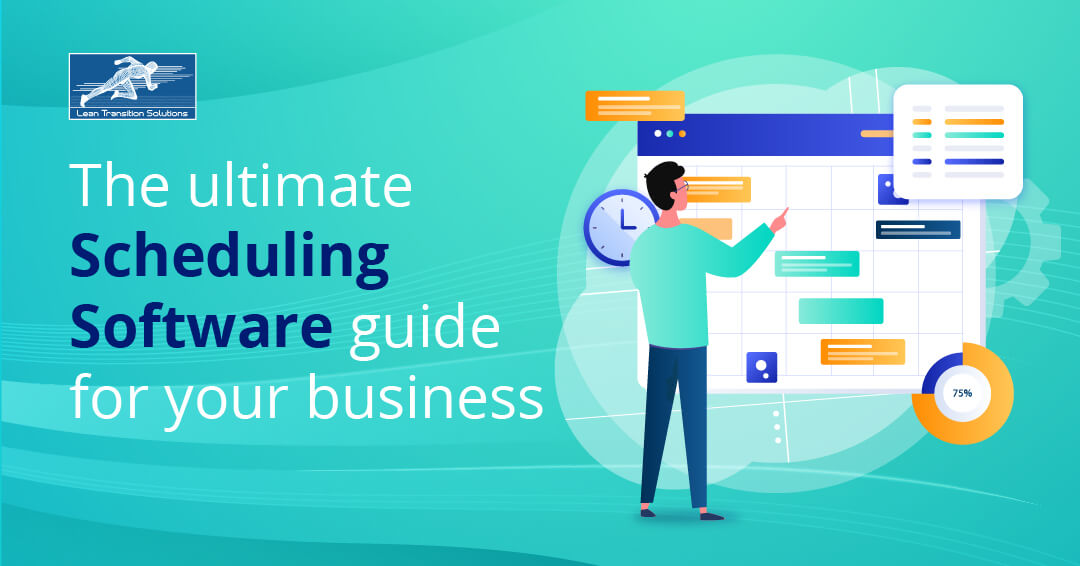The ultimate Scheduling Software guide for your business
August 11, 2023
A seamless and well-organised scheduling system can result in successful business operations, facilitating the optimal allocation of resources and the effective management of tasks. As businesses strive to maximise productivity, minimise costs, and enhance customer satisfaction, the ability to manage schedules has become a critical factor.
Whether assigning tasks to employees, coordinating project timelines, or ensuring that facilities and equipment are utilised to their fullest potential, choosing the right scheduling software plays a significant role in streamlined operations.
As we delve deeper into this guide on business scheduling needs, let's understand how to choose the right scheduling solution for your business. The best scheduling software enables you to make informed decisions that align with your business's unique needs and goals.
Importance of Efficient Scheduling
Effective scheduling lies at the core of smooth business operations, influencing various facets of an organisation's functionality. Efficient scheduling and workflow optimisation are key to maximising productivity. By systematically scheduling tasks, projects, and meetings, employees can focus on their work without unnecessary interruptions or overlaps. This results in heightened productivity, as employees can dedicate their time and efforts to the assigned tasks without confusion arising from poor scheduling practices.
Effective scheduling also minimises downtime and reduces bottlenecks in production. Businesses can mitigate instances where personnel or equipment are left idle due to the lack of coordination by strategically allocating resources and time. Streamlined operations save valuable time and optimise resource utilisation, translating to cost savings and improved profitability.
How to choose the right Scheduling Software for your business?
Step 1: Identifying your business needs and objectives
Identifying your business's specific needs and objectives is essential to make an informed choice when choosing the scheduling software.
- Assessing current scheduling challenges: Begin by evaluating your current scheduling processes. Identify pain points, bottlenecks, and inefficiencies in your current system. This assessment will help you pinpoint areas that need improvement and guide your search for appropriate scheduling software.
- Defining your business's unique requirements: Every business has its own set of requirements when it comes to scheduling and resource allocation. Consider factors such as the number of employees, types of services offered, project complexity, and the frequency of appointments. This analysis will help you understand what functionalities your scheduling software requires.
- Setting clear objectives for scheduling and resource allocation: Clearly define your scheduling goals. Are you looking to reduce scheduling errors, improve client satisfaction by scheduling meetings or increase employee productivity? Set concrete objectives that will be benchmarks for selecting the right software solution for your scheduling needs.
Step 2: Assessing factors in a Scheduling Software
Before making a purchasing decision for scheduling software, it's crucial to assess various factors thoroughly.
- Scalability and Flexibility: Ensure the software can grow alongside your business. Choose a solution to accommodate increasing meeting schedules, employee scheduling, and resource management without compromising performance. Flexibility to adapt to changing business needs is crucial.
- Cost and budget considerations: Evaluate the pricing structure of the software and ensure it aligns with your budget. Consider the initial installation cost, ongoing subscription fees, and potential Return on Investment (ROI) through increased efficiency.
- User training and support options: Look for software providers that offer comprehensive user training and reliable customer support. Smooth onboarding and responsive assistance will minimise disruptions during the transition.
- Security and data privacy measures: The software should adhere to industry-standard security protocols to protect your sensitive business and customer data. Features like role-based access control and data encryption are essential for maintaining data privacy.
Step 3: Look for necessary features in a Scheduling Software
When searching for scheduling software, it's important to prioritise essential features that meet your business's immediate needs and support your long-term growth and success.
- User-friendly Interface: An intuitive and easy-to-use interface is crucial for quick adoption by your team. A user-friendly design minimises the learning curve and reduces the chances of errors during scheduling.
- Customisation Options: The software should allow you to tailor it to your business's specific needs. Customisation lets you prioritise and schedule events easily, enhancing overall operational activities.
- Integration Capabilities: Seamless integration with your existing systems, such as calendars, CRM software, and project management tools, is essential. This integration prevents double-entry of data and streamlines workflows across different platforms.
- Reporting and Analytics: Robust reporting features provide insights into scheduling trends, employee performance, resource utilisation, and more. Data-driven insights empower better decision-making and help you identify areas for improvement.
- Mobile Accessibility: In today's mobile-driven world, scheduling software that can be easily accessed on smartphones and tablets is crucial. This ensures that you and your team can manage schedules and appointments on the go, enhancing flexibility and responsiveness.
- Automation Features: The software should offer automation options for routine tasks like sending reminders, notifications, and recurring schedules. This saves time and reduces the risk of errors.
- Trial Period: Many scheduling software options offer free trials. Before committing, take advantage of these to thoroughly check the software's features, functionality, and compatibility with your business.
Resource Allocation in Scheduling Software
Proper resource allocation is intricately linked to efficient scheduling as it offers a multitude of benefits that contribute to the overall success of business operations. One notable advantage is the maximisation of resource utilisation. Let it be your employees, equipment, or assets; allocating resources effectively ensures that each component is put to its best use. This prevents wastage and enhances each resource's Return on Investment (ROI).
Moreover, proper resource allocation promotes a balanced workload distribution among employees or teams. By considering skill sets, availability, and preferences, businesses can assign tasks to individuals best equipped to handle them, reducing burnout and fostering a healthier work environment.
In addition, sound resource allocation facilitates better risk management. When resources are allocated judiciously, the impact of unexpected events or setbacks can be mitigated more effectively. Effective resource allocation and scheduling help adapt to changing market conditions or address unforeseen challenges.
Tips for implementing Scheduling Software effectively
- Planning and preparing for software integration: Before implementation, outline a detailed plan that includes data migration, system integration, and potential downtime. Adequate preparation ensures a smooth transition without disrupting ongoing operations.
- Involving stakeholders in the decision-making process: Engage relevant stakeholders, such as managers, team leaders, and end-users, in the software selection process. Their input can lead to a solution that meets diverse needs and garners better acceptance.
- Training employees for seamless adoption: Provide comprehensive training to employees to familiarise them with the new software's features and functionalities. This reduces resistance to change and ensures efficient utilisation of the software's capabilities.
- Monitoring performance and making continuous improvements: Regularly monitor how the software impacts scheduling and resource allocation. Collect feedback from users and assess the performance. Use this data to make necessary adjustments and enhancements over time.
- Make a troubleshooting plan: Create a troubleshooting guide to address issues swiftly. Offer timely support to users facing difficulties, provide clear communication about the transition process, and have contingency plans to handle unexpected disruptions.
How do different organisations utilise Scheduling software?
Various organisations utilise scheduling software, such as T Cards, to enhance their shop floor operations in diverse ways.
- Manufacturing Companies: Manufacturing firms often use scheduling software to allocate machinery, equipment, and personnel to different production tasks. Digital T Cards can be used in manufacturing to visually represent production timelines, allocate resources efficiently, and track work progress.
- Healthcare Sector: Hospitals and clinics utilise scheduling software to manage patient appointments, allocate medical staff, and allocate resources like examination rooms and medical equipment. T Cards can be used in healthcare sectors for optimising patient flow, scheduling appointments and reducing waiting times.
- Construction Industry: Construction companies utilise scheduling software to coordinate construction projects, allocate labour and equipment, and manage project timelines. The T Card system can visually map out tasks, ensuring seamless coordination among various teams in the construction sector.
- Service-Based Businesses: Service-oriented organisations, such as consulting firms, use scheduling software to manage appointments and allocate staff resources. T Cards can aid in optimising employee schedules, preventing overbooking, and ensuring timely service delivery.
- Retail Industry: Retailers employ scheduling software to manage employee shifts, ensuring adequate staffing during peak hours. In the retail industry, Digital T Cards can help allocate shifts, manage breaks, and ensure smooth store operations.
- Transportation and Logistics: Companies in the transportation and logistics sector use scheduling software to allocate delivery routes, track vehicle availability, and manage driver schedules. T Cards can help coordinate shipments and optimise delivery timelines in the transportation industry.
- Project Management: Businesses can use scheduling software for project management, allocating tasks, setting deadlines, and monitoring progress. T Card systems can visually represent project timelines and resource allocation for improved decision-making processes.
- Hospitality Industry: Hotels and restaurants utilise scheduling software to manage staff shifts, allocate tables, and coordinate events. T Cards can help optimise staff schedules and ensure smooth guest experiences in the hospitality industry.
Organisations utilise scheduling and resource allocation software like T Card systems to streamline operations, improve resource utilisation, enhance productivity, and provide better customer or client services. The specific ways they use these systems vary based on their industry, needs, and goals.
In the ever-evolving landscape of modern business, mastering the art of efficient scheduling and resource allocation is not just a choice but a necessity. As we've explored in this comprehensive guide to scheduling software, the key to achieving operational excellence lies in carefully selecting and implementing the right tool for your business. From understanding the significance of streamlined scheduling and optimal resource distribution to navigating the intricate process of choosing, integrating, and maximising a scheduling software's potential, you're now equipped with the insights to propel your business forward.
Remember, the journey doesn't end with selecting the right scheduling software; it's a continuous process of refinement and adaptation. As businesses face dynamic challenges and opportunities, the flexibility and insight provided by these tools will serve as cornerstones of innovation and progress. By embracing the power of advanced scheduling solutions, businesses of all sizes and industries can pave the way for a future where precision, efficiency, and growth intertwine seamlessly. Your business's success story starts here as you harness the potential of scheduling software to elevate your operations and define a new era of accomplishment.
